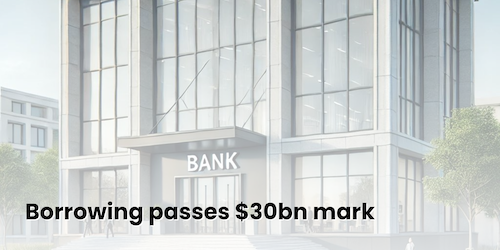There are lots of ways of measuring time.
We are now a quarter of the way through the tax year, three-quarters of the way towards New Year’s Eve and Spring is approaching its halfway mark. Plus, school holidays are coming to an end and the final Term 4 is about to start. For those in Year 12, the fun is about to begin in earnest and for those hanging out for a nice present this year, it’s time to be good.
Great news for buyers, with more property listings coming onto the market this spring. Here’s what else is making news right now:
- Best rates
- The winner’s curse
- The power of the mind
- Lenders, lenders everywhere
- Borrowing passes the $30bn mark
- 5 common car loan mistakes
- Home values rise another 0.5%
- Govt helping property buyers
Read more below.

Rates below as at: 25 September 2024
There has been some downward movement in Fixed Rates as noted below. This may have a few reasons behind this, the most obvious being the cost of funds for the lenders for these fixed terms, which in turn may reflect the market’s expectations of future rate movements in the near term.
Owner Occupiers
Principal and Interest
• Fixed Rates: from 5.54% pa – 2 year term
• Variable Rates: from 5.99% pa (excluding ‘clean energy’ loans)
Interest Only
• Fixed Rates: from 5.89% pa – 2 and 3 year terms
• Variable Rates: from 6.14% pa
Investors
Principal & Interest
• Fixed Rates: from 5.79% pa – 2 and 3 year terms
• Variable Rates: from 6.19% pa
Interest Only
• Fixed Rates: from 5.79% pa – 2 and 3 year terms
• Variable Rates: from 6.34% pa
The winner’s curse

My investment hero
For those who have been regular readers of our newsletters, you know I am a big fan of Philip Anderson, who, with his team, has written extensively about the ‘18.6-year cycle’ (Google this, and you will find out more).
If that sounds a bit precise, Philip goes on to say that this cycle can be as short as 17 years and as long as 21 years. But you get the drift.
Why is it important to understand the real estate cycle? Well, understanding this cycle can be important if you are looking to buy (or sell) and it can also be very important if you are gearing up to buy, particularly if you are stretching yourself to the last dollar.
According to Philip, we are entering the phase of the Winner’s Curse – when everything is going up, and it seems like there is no end to the upward spiral.
Except there is.
At this stage of the cycle, look out for…..
Governments are in stimulus mode!
The stimulus can take various forms such as:.
- Reducing interest rates
- Investing in infrastructure projects like bridges, roads, or airports (see what is happening in the Eastern States).
- Changing zoning rules to permit more construction or offering subsidies to encourage businesses to set up domestically (see my blog last month on the rumoured changes in Victoria’s planning rules).
- Adjusting reserve requirements, allowing banks to lend more.
- Changing regulations on share buybacks or increasing margin trading to boost demand and raise share prices.
During this last phase of the cycle, the tallest buildings are being built*, the largest developments are being planned*, and the housing shortages are about to be solved with new and not-so-new solutions. (I find it particularly enlightening when Phil pulls out a media article from the end of the last cycle, which could have been written yesterday. And these stories emanate from within Australia as well as across the world).
And in the US, this hubris not surprisingly coincides with the Presidential elections. In an election year, it is common for the economy to be pumped full of money to assist with the re-election of the incumbent President (this is not political – all Presidents do it!).
* Footnote: Oklahoma is about to become the home of the tallest building in the US and the sixth tallest in the world – Oklahoma, the State with a population of 4 million where the largest city has a population of 643,000 …. I kid you not. And Neom, in Saudi Arabia, is a USD$500 BILLION dollar multi-city development…. eye watering.
So, you can buy into the property market but you need to be aware. Aware of carrying too much debt and aware of the power of exuberance.
We advise clients that borrowing is fine, but don’t over-borrow beyond your means and keep one eye on your fall-back strategy.
Some other things to watch per Phil and his team
At this stage of the cycle, the US Dollar tends to weaken.
When the world is increasingly optimistic about ongoing economic development, there is a higher tolerance for risk. This is especially true as most stock markets are at, or near, all-time highs, meaning that investors are generally in profit.
In the US, both the government and major banks are actively creating money, flooding the global market with dollars. As a result, the value of the U.S. dollar is falling relative to other currencies.
A weakening US dollar for Australia investors means….
A weakening US dollar will mean that the return from any investments you have made in US dollars will be reduced once these investments are converted back into Australian dollars.
Talking about these things is one thing. To understand them is another!
In brief, a weakening US dollar will mean that the current exchange rate of 0.68 (i.e. 1 Australian dollar equals 0.68 US dollars), will rise so that 1 Australian dollar will buy more US dollars (for example, 0.75 US dollars).
So if you see this movement in the exchange rate, you heard it here first.
Some counter-intuitive advice
Given this advice, it might sound counter-intuitive but we also recommend a few strategies around the canny use of Offset accounts so you can borrow and hold surplus funds while lenders will lend to you but not have these additional loan funds cost you anything in terms of repayments and interest.
We recommend this strategy because one thing we know: ‘A lender will never lend you an umbrella when it is raining’ – so get the money while you can but don’t let it cost you anything until you need it to make you more money.
There is a lot more to this strategy and determining its suitability for you.
To find out how you can safely use Offset accounts,
shoot me an email.

The power of the mind
If you asked me what I thought about mindset coaching, hypnotherapy and other mind-altering approaches to life 20 or 30 years ago, I would probably have looked at you blankly.
These days, I think I know more, and, I am starting to understand a little bit more about the importance of how we think and how this influences what we do.
My transformation has been slow, but it probably started way back when I was getting some post-divorce counselling. In addition to some counselling, I read a lot of books. Books like Men Are from Mars, Women Are from Venus, The Road Less Travelled, as well as a book whose name I can’t remember, which explained the 7 stages of grief.
Fast forward a few years and a good friend, David Austin, introduced me to some interesting books from the Arbinger Institute called The Anatomy of Peace and Leadership and Self-deception.
I then expanded my reading to include influential books by Daniel Pink, Malcolm Gladwell and Simon Sinek.
And in 2016, I decided to be serious about losing some weight. I used hypnotherapy from Roberta Connelly Seddon Hypnotherapy, to apply a virtual gastric band. Over 9 months, I lost close to 20 kgs. (8 years later and I need a new virtual gastric band!).
I now need a touch-up in a few areas (I am like a car which needs some TLC!). With the help of Rod Walker, Quantum Shift Success Coaching, I am applying the principles of the mind to focus on what is really important to me.
The moral of this article?
At different stages of our lives, we all need to work on self-improvement, and there are lots of ways to do this.
As I say to my 14-year-old twin boys, ‘The teacher appears when the student is ready to learn’. (Footnote: I don’t know if they think I am ‘the teacher’! 🤣)
So as you traverse life and family and work and pleasure,
keep an eye out for your teacher.

Lenders, Lenders everywhere
aka what makes us so special
The one thing brokers like to talk about is the number of lenders they have on their panel. This is one of a broker’s core offerings and competitive advantages. But hey, it is also a bragging rights thing 🤩.
Without a broker, a client is restricted to walking into one of the retail shops of one of the Big 4 (plus a few others) or, shopping online to try and get the best deal. Try doing that a few times before you get worn out and exhausted!
In saying this, sometimes, clients can snag a great deal. And in those situations, we say ‘Go for it!’ as good deals can be hard to find.
However, in most cases, having the broker do the hard yards for you is often time-saving, stress-saving and money-saving.
Our Lender Panel
We are fortunate to be part of the Loan Market Group. As the largest aggregator group (LMG has over 5,000 mortgage brokers Australia-wide – but we are the best 🤗), they have vetted a large number of lenders to make sure you get the best selection of lenders available no matter what your finance needs.
Just to give you an idea, on LMG’s panel, we have access to lenders for:
• Residential property loans – 63 lenders
• Asset finance loans – 30 lenders
• Commercial finance loans – 29 lenders
• Small business cashflow finance – 11 lenders
• Deposit bonds – 2 providers
• Personal loans – 8 lenders
• SMSF loans – 15 lenders
Some of these lenders you will know but most of them are ‘broker-only’ lenders so you may not have heard of them. However, LMG does the due diligence to make sure they are legit and credible, and as the largest aggregator, they can be persuasive when we need them to assist us 👍.
The advantages BIR Finance adds to the mix
The above lender numbers are impressive.
But the really impressive part is our access to advanced software capabilities plus manual ‘hands-on’ expertise which we use to convert this information into knowledge for you. Some of these software tools are provided by LMG and some are sourced from third parties who are recognised and approved by LMG.
For those of you who have started the loan process with us, you will know that we kick off your first consultation with a quick 30-minute Zoom session to uncover ‘who will lend to you and how much they will lend you’.
And, we will then show you the costs for the top 5 or so lenders. But rather than focus on the 30-year cost of the loan, we draw your attention to the first 2-year cost as we recommend our clients scan the lender market every couple of years (we recommend this for two main reasons: 1) your circumstances can change over time and 2) most lenders like to edge up your rates if you are not looking 😎).
And then, if you have a property (or are looking to buy a property), we also show you the estimated value of the property as per the major property research sources (CoreLogic and Pricefinder). This allows you to work out the likely Loan to Value Ratio (LVR) which can be important when assessing product and interest rate selection.
However, we even go a step further for those difficult-to-place deals. We can use lenders who are ‘off-panel’, particularly when they will do a particular deal when other lenders won’t – or they will offer a particularly sharp rate or flexible term.
In the last year, we have done a couple of deals with off-panel lenders, and they have saved clients in situations where the clients really needed a solution.
To find out a bit more or experience what our clients have experienced, book a time for a quick Zoom.

Home loan borrowing has risen for seven consecutive months, indicating a rise in both the number of purchasers and their average loan amount.
From December 2023 to July 2024, the volume of new monthly home loan commitments (excluding refinancing) increased by 17.1%, from $26.126 billion to $30.584 billion, as per the Australian Bureau of Statistics.

If you’re considering applying for a home loan, here are some tips to enhance your borrowing capacity:
- Cut back on your spending. Search for ways to trim your discretionary spending, so lenders can see you’re able to manage higher mortgage repayments.
- Lower your credit card limit. Even if you pay off your debt in full each month, lenders recognise that this could change, impacting your ability to meet mortgage repayments. A lower credit card limit could make you appear more creditworthy to lenders.
- Clear existing debts. If feasible, settle any personal and car loans to increase your disposable income available for a mortgage.
- Boost your credit score. One method is to obtain a free copy of your credit report from Illion, Equifax, or Experian; check for any incorrect negative entries; and request their removal if found.
- Consult a broker. Your borrowing potential can vary greatly between lenders – sometimes by over $100,000. I work with a broad panel of lenders, which enables me to match you with a lender who may view your financial situation more favourably.

Most people have a favourable experience when they secure a car loan. Occasionally, however, borrowers unintentionally place themselves in a tricky situation by committing a few of these errors:
Not understanding your finances. You should never borrow more than you can comfortably afford to repay. So, before you apply for a loan, it’s crucial to have a clear understanding of your income, expenses, and cash flow—both currently and in the foreseeable future.
Not focusing on life-of-loan costs. Don’t assess the cost of a loan solely by a single interest payment, as this can be misleadingly low. Instead, consider all the interest payments you’ll need to make throughout the duration of the loan, and then factor in any additional fees.
Not checking your credit report. Your credit rating might be lower than you think, which could make it more difficult to qualify for a loan or might lead you to accept a higher interest rate. Therefore, it’s wise to request a free copy of your credit report before you apply for a car loan.
Not obtaining a pre-approval. It’s risky to sign a purchase agreement without having your finance sorted, as you won’t know how much you can borrow. You can reduce this risk by securing a car loan pre-approval before you begin your search for a vehicle.
Not using a broker. If you source your finance directly from a bank, you’ll have only one option to consider; from a dealer, perhaps just one or a few. However, by going through a broker, you can compare loans from a wide array of lenders, significantly enhancing your chances of securing a better deal.

The property growth cycle is ongoing for now, yet it seems closer to its conclusion than its start.
Australia’s median property price climbed by 0.5% in August, marking the 19th straight month of increase, as reported by CoreLogic. However, CoreLogic noted that “the rate of growth is evidently slowing.”
CoreLogic has pinpointed two factors for this deceleration.
Firstly, affordability issues are starting to impact – buyers cannot continue to afford escalating prices indefinitely while household incomes stay at their present levels. Secondly, although demand still surpasses supply, the disparity between them is narrowing.
Eventually, this growth cycle will terminate, which will be entirely typical. Historically, Australia’s property market has experienced cycles: prices usually increase for a period then decrease, with the rises generally outstripping the declines.

The nation’s median property price has increased by 70.2% over the past 10 years, 157.9% over the past 20 years and 425.9% over the past 30 years, according to CoreLogic.

First home buyers and single parents struggling to enter the property market can find encouragement in a recent report from Housing Australia.
The report reveals that around one in three first home buyers who acquired property in the 2023-24 financial year utilised the federal government’s Home Guarantee Scheme (HGS). The HGS allows first home buyers – and those who haven’t owned a home for at least 10 years – to buy a property with just a 5% deposit and no need to pay lender’s mortgage insurance (LMI).
Additionally, over 1,000 single parents and single legal guardians benefitted from the scheme last financial year. The HGS enables single parents and guardians to purchase a property with only a 2% deposit, also without the burden of LMI.

The HGS offers a variety of eligibility requirements, including:
- Buyer type: participants must be owner-occupiers.
- Income caps: no more than $125,000 for individual applicants and $200,000 for joint applicants.
- Property price caps: these differ by location (refer to the table above).
Get in touch if you’re interested in the HGS: I can determine if you meet the eligibility criteria and handle your home loan application.
Check our other latest blogs!


